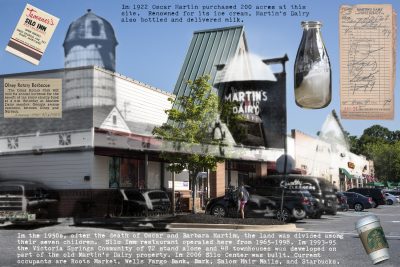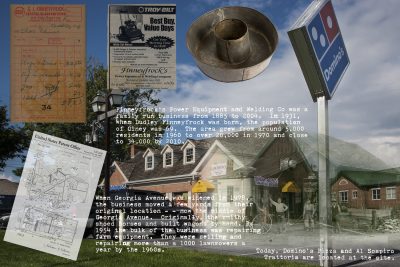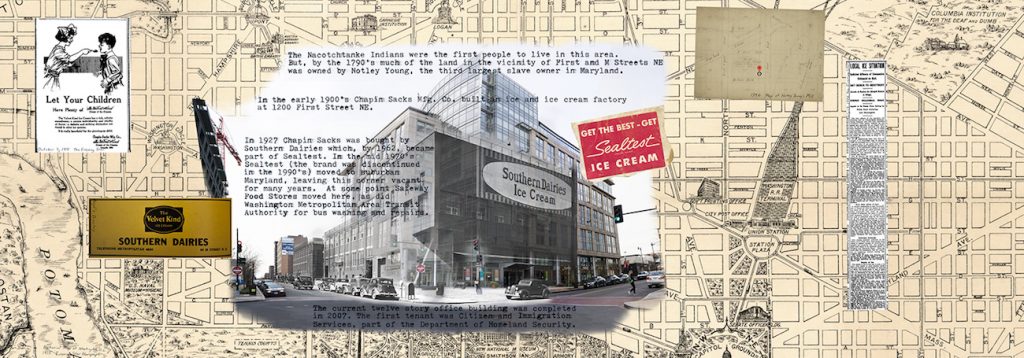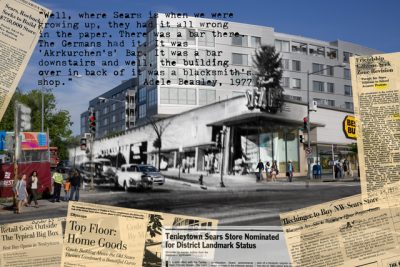If you see someone hanging back from the public art installation on display at Roots Market in Olney, it might just be the artist Gail Rebhan.
When she did a photo collage exploring the past and present of her Tenleytown neighborhood in 2009, she would often hang back and watch people’s reactions. “People were always really astonished because they had no idea of what had been there before,” she said. “A lot of people do stop (to look). The work that I do is really dense. There is a lot to see if you take the time.”
The Roots Market piece shows the site as it is now along with echoes from its past–including that it once was the home of Martin’s Dairy and Ice Cream Shop. “I really love having a public art component to (the exhibit) because then people who are not specifically going to see an exhibition will see the art and it is about that specific site,” she said.

The installation is part of Rebhan’s exhibit “Palimpsest: Layers of Time” at the Sandy Spring Museum. (The word “palimpsest” means something reused or altered but still bearing visible traces of its earlier form.) Ten new large-scale photographic assemblages look at different locations in the Sandy Spring area incorporating archival and contemporary photographs along with historical newspaper articles, maps, advertisements, ephemera and text.
Rebhan began an artist residency with the museum last summer and the exhibit is part of the guidelines for the position. “The work that (Rebhan) has done was really similar to something we have had in mind for years, which is using the archives, specifically historic photos but using them in a modern context to interpret history so what her work does is exactly that,” said Allison Weiss, the museum’s executive director. “(The exhibit and her work) really illustrate the continuum of history, which we are also very interested in doing. Not showing history as ‘These are things that happened in the past and have no correlation to what is happening today.’ Her work exactly illustrates how history impacts everything that happens today.”
The exhibit allows patrons to understand history through their visual senses rather than reading it. “It gives you a completely different perspective of places you see every day, but you are seeing it through the eyes of an artist,” Weiss said. “There is very little written on local history. It is not like you can find this information someplace else. The art is making it accessible in a way that it is not already accessible.”

One piece, “18035 Georgia Avenue, Olney, Maryland-1917/2016,” shows the evolution of a family business. Begun as Finneyfrock’s blacksmith shop, the business later evolved into Finneyfrock’s Power Equipment and Welding Company. Today, it is the site of a Domino’s Pizza and Al Sospiro Trattoria. Rebhan’s photo collage uses a photo from 1917 and one from 2016 paired with a 1956 receipt, a 1999 advertisement and a 1967 patent document.
This piece, along with nine other new compositions, will be on display in addition to some 20 other pieces from Rebhan’s portfolio that also explore the past and its relationship and influence on the present–including a 6-by-17-foot fabric site-specific banner for the Washington Project for the Arts Lobby Project.
“I think my approach is an unsentimental look at the past,” Rebhan said. “I am trying to be very factual about how areas evolved and changed and how this reflects our shifting vales. Sometimes it is market forces. Sometimes it is government action that causes these things to change. I do think my work is really about time and memory. I think photography is inherently about time to some degree because you take this moment and then it is in the past.”

Rebhan was a communications major at Antioch College in Ohio when she began making documentary videos and migrated toward still photography. “Most people go the other way around,” she said. “I think there is a real power in the still image that you can contemplate for as long as you want to. In terms of the way our memory works, we tend to remember still images longer. I really am attracted to the power of a still image, although I still work in video a little bit.”
Having earned a master’s degree from the California Institute for the Arts, Rebhan is a photography professor at Northern Virginia Community College. “I am obviously very passionate about photography, so (my job) gives me the opportunity to talk about photography all the time,” she said. “I really like my interaction with students and seeing them grow and become more sophisticated in their use of images. Also, it is a profession that allows me to be active as an artist as well. I don’t teach in the summers, so I do most of my creative work in the summer.”

For this exhibit, Rebhan heavily researched each site’s history. She printed out old photographs of the sites, then went to the current location to capture it as it is today. She would try to line up the photo using still-existing landmarks whenever possible, combining the old and new images in Photoshop and adding historical items to the piece. “It was really interesting because this is the first project I have done that was in an area that had been primarily rural until recently,” she said.
All the sites chosen are basic ones–none with any significant historical importance to the area. “They always seem to be very reflective of our larger culture and how society has changed and how the needs change,” she said. “There is a strong historical and sociological component to my work. I think (people) can see how our culture has changed in terms of the specific use changing of the site. One thing that happens, people start thinking about their own neighborhoods or the towns they are from and how that has changed over time. It really opens people’s eyes to thinking about how things are constantly in flux and how that reflects how our society has changed.”
“Palimpsest: Layers of Time” is on view through June 24 at the Sandy Spring Museum, 17901 Bentley Road, Sandy Spring, and off-site at Roots Market and Shoppers Warehouse on Georgia Avenue in Olney. Visit www.sandyspringmuseum.org. View this exhibition on CultureSpotMC here.